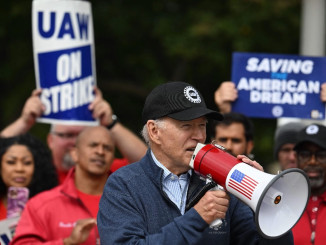One of the most important working class holidays, May Day, originated in the U.S. in the 1880s, with the struggle for the 8-hour-day. The working class was engaged in a constant struggle for a reduced work week – a struggle against the constant attempt by the bosses to extend the working day. Many workers suffered from extreme conditions, working up to 16 hours per day for barely any money. Strikes and pressure for legislation to reduce working hours became a rallying cry for U.S. workers.
In the 1880s an economic depression, along with resulting unemployment and wage cuts pushed the movement forward. May 1, 1886 was chosen as the date for the fight to be launched. On the job, in the neighborhoods, at the union halls, at home – the struggle for the 8-hour day was the focus of many workers. They took up the slogan – “Eight hours for work, eight hours for rest, eight hours for what we will!”
The bosses were also preparing. There was a huge propaganda campaign in the media, the formation of paramilitary groups, and an expansion of the police and National Guard, all of which pointed to major violence.
In early spring, strikes demanding the 8-hour day began to break out, involving almost a quarter of a million workers, The movement was strongest in the big working class centers, but it spread all over the Midwest and east coast. Mass rallies, parades and demonstrations involving thousands of workers took place around the country. Brewers, bakers, furniture workers, clothing cutters, tobacco, shoe, packinghouse and other workers won their fight and their hours were reduced.
On May Day, tens of thousands of workers struck and tens of thousands more took to the streets to support the fight. It was a festival of the oppressed, with bands and flags and joy. Over the next days 340,000 workers stopped work in 12,000 work places around the country. Many of the struggles were victorious.
The leaders of these strikes, especially in Chicago where the movement was strongest, were revolutionaries – socialist and anarchist militants who opposed the capitalist system, and believed that workers could put an end to capitalism and run society to meet the needs of those who do the work, rather than the profits of the wealthy. The goal of reducing exploitation in the workplace was a necessary step in this direction.
On May 3, in Chicago police attacked striking workers, killing four people and wounding 200. The next day the workers held meetings and rallies to protest the killings and police brutality. At one meeting, in Haymarket Square, as the last speaker was finishing up, hundreds of police marched in and declared that the rally must disperse. At the same time dynamite began to explode among the police – wounding dozens and eventually killing seven. The cops fired into the crowd wounding hundreds and killing several. Eight anarchists were charged with the bombing even though there was no evidence that they were involved. Seven were sentenced to hang and one to a long prison term. The Federal government used the frame-up of the anarchists to launch a campaign of repression against revolutionaries and union activists across the U.S.
Despite these attacks, the movement continued. There were over 1400 strikes involving over half a million workers in 1886. The strike wave showed the potential power of the newly emerging industrial working class. It showed a high level of class solidarity, including across racial lines. The workers challenged the right of the bosses to control the workers’ lives.
In 1888 the fight continued for the 8-hour day. In 1889, workers organizations from around the world voted to designate May 1, 1890 as an international day of solidarity to continue the fight for the 8-hour day and to honor workers’ struggles and the revolutionaries who died for the cause of the working class. May Day continues to be celebrated by workers and their organizations all over the world.
Today, working people are all under attack. Millions are unemployed. Those who are working are over-worked and facing constant attacks in the form of harassment and take-aways of wages and benefits. The government cuts to social spending are stripping all of us of the right to quality education, healthcare, and transportation. It is time to recall the lessons of our history – all workers, both immigrant and native born. During this May Day we can see it is past time for us to remember the lessons of the eight-hour day movement, and to join together and fight for a better world.




